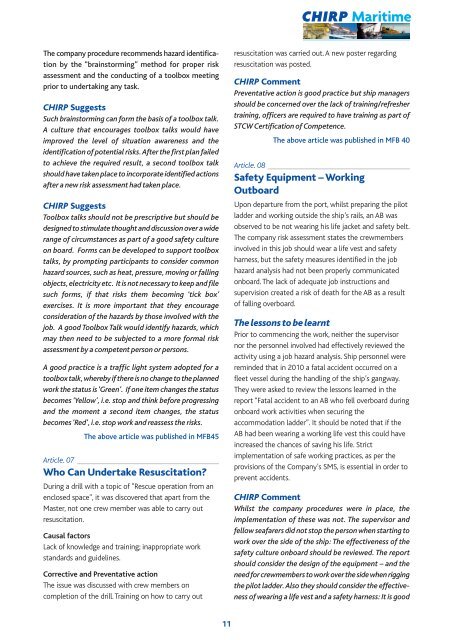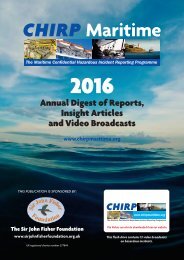CHIRP annual digest 2016 flip
You also want an ePaper? Increase the reach of your titles
YUMPU automatically turns print PDFs into web optimized ePapers that Google loves.
<strong>CHIRP</strong> Maritime<br />
The company procedure recommends hazard identifica -<br />
tion by the “brainstorming” method for proper risk<br />
assessment and the conducting of a toolbox meeting<br />
prior to undertaking any task.<br />
<strong>CHIRP</strong> Suggests<br />
Such brainstorming can form the basis of a toolbox talk.<br />
A culture that encourages toolbox talks would have<br />
improved the level of situation awareness and the<br />
identification of potential risks. After the first plan failed<br />
to achieve the required result, a second toolbox talk<br />
should have taken place to incorporate identified actions<br />
after a new risk assessment had taken place.<br />
<strong>CHIRP</strong> Suggests<br />
Toolbox talks should not be prescriptive but should be<br />
designed to stimulate thought and discussion over a wide<br />
range of circumstances as part of a good safety culture<br />
on board. Forms can be developed to support toolbox<br />
talks, by prompting participants to consider common<br />
hazard sources, such as heat, pressure, moving or falling<br />
objects, electricity etc. It is not necessary to keep and file<br />
such forms, if that risks them becoming ‘tick box’<br />
exercises. It is more important that they encourage<br />
consideration of the hazards by those involved with the<br />
job. A good Toolbox Talk would identify hazards, which<br />
may then need to be subjected to a more formal risk<br />
assessment by a competent person or persons.<br />
A good practice is a traffic light system adopted for a<br />
toolbox talk, whereby if there is no change to the planned<br />
work the status is ‘Green’. If one item changes the status<br />
becomes ‘Yellow’, i.e. stop and think before progressing<br />
and the moment a second item changes, the status<br />
becomes ‘Red’, i.e. stop work and reassess the risks.<br />
The above article was published in MFB45<br />
Article. 07<br />
Who Can Undertake Resuscitation?<br />
During a drill with a topic of "Rescue operation from an<br />
enclosed space", it was discovered that apart from the<br />
Master, not one crew member was able to carry out<br />
resuscitation.<br />
Causal factors<br />
Lack of knowledge and training; inappropriate work<br />
standards and guidelines.<br />
Corrective and Preventative action<br />
The issue was discussed with crew members on<br />
completion of the drill. Training on how to carry out<br />
resuscitation was carried out. A new poster regarding<br />
resuscitation was posted.<br />
<strong>CHIRP</strong> Comment<br />
Preventative action is good practice but ship managers<br />
should be concerned over the lack of training/refresher<br />
training, officers are required to have training as part of<br />
STCW Certification of Competence.<br />
The above article was published in MFB 40<br />
Article. 08<br />
Safety Equipment – Working<br />
Outboard<br />
Upon departure from the port, whilst preparing the pilot<br />
ladder and working outside the ship’s rails, an AB was<br />
observed to be not wearing his life jacket and safety belt.<br />
The company risk assessment states the crewmembers<br />
involved in this job should wear a life vest and safety<br />
harness, but the safety measures identified in the job<br />
hazard analysis had not been properly communicated<br />
onboard. The lack of adequate job instructions and<br />
supervision created a risk of death for the AB as a result<br />
of falling overboard.<br />
The lessons to be learnt<br />
Prior to commencing the work, neither the supervisor<br />
nor the personnel involved had effectively reviewed the<br />
activity using a job hazard analysis. Ship personnel were<br />
reminded that in 2010 a fatal accident occurred on a<br />
fleet vessel during the handling of the ship’s gangway.<br />
They were asked to review the lessons learned in the<br />
report “Fatal accident to an AB who fell overboard during<br />
onboard work activities when securing the<br />
accommodation ladder”. It should be noted that if the<br />
AB had been wearing a working life vest this could have<br />
increased the chances of saving his life. Strict<br />
implementation of safe working practices, as per the<br />
provisions of the Company’s SMS, is essential in order to<br />
prevent accidents.<br />
<strong>CHIRP</strong> Comment<br />
Whilst the company procedures were in place, the<br />
implementation of these was not. The supervisor and<br />
fellow seafarers did not stop the person when starting to<br />
work over the side of the ship: The effectiveness of the<br />
safety culture onboard should be reviewed. The report<br />
should consider the design of the equipmen t – and the<br />
need for crewmembers to work over the side when rigging<br />
the pilot ladder. Also they should consider the effective -<br />
ness of wearing a life vest and a safety harness: It is good<br />
11



